Gigantic IceCube tightens limits on theories that predict dark-matter particles
DOI: 10.1063/PT.3.1966
Cosmology’s widely accepted concordance model attributes only about one-sixth of the present mass density of the cosmos to baryonic matter—protons and neutrons. The dominant nonbaryonic mass is presumed to consist of some still-unknown dark-matter particle species, impervious to electromagnetic and strong nuclear interactions. The seminal role assigned to dark-matter particles in galaxy formation requires that they be stable and significantly heavier than the proton. Hence the name WIMPs—weakly interacting massive particles.
Quite apart from cosmological considerations, particle physicists had predicted just such WIMPs by positing a supersymmetry between bosons and fermions in attempts to expand particle theory’s standard model. Supersymmetric models predict an abundance of new heavy species—a bosonic partner for every fundamental fermion and vice versa. But none has yet been found, and mass predictions are varied and vague.
The favored dark-matter candidate at present is χ0, the lightest of a family of uncharged, spin-½ “neutralinos” predicted by so-called minimal supersymmetric standard models (MSSMs). Model variations and experimental null results put its mass mχ somewhere between 10 and 10 000 times the 0.9-GeV mass of the proton.
An MSSM WIMP’s likelihood of scattering off a nucleus is no larger than that of a neutrino. In recent years, various experimental groups have searched for nuclear recoils from such rare collisions in sensitive detectors weighing at most a few tons and sited deep underground for shielding against cosmic-ray backgrounds. (See, for example, Physics Today, February 2010, page 11
Most WIMP searches invoke a standardized approximation of the dark-matter halo presumed to envelop the spinning Milky Way. The solar system plows at about 300 km/s through the stationary halo, whose local dark-matter density is taken to be 0.3 GeV/cm3. So one might expect a nuclear recoil experiment to reveal a few WIMP collisions per year. But as yet, the observed event rates have been consistent with expected backgrounds.
Recently the gargantuan IceCube neutrino observatory, a cubic kilometer of instrumented ice deep under the South Pole, has entered the WIMP search with a different approach. Instead of looking for recoils from WIMP collisions, it looks for neutrinos from the mutual annihilation of WIMPs gravitationally trapped near the center of the Sun.
The IceCube collaboration, led by Francis Halzen (University of Wisconsin–Madison), has now reported a new null result that tightens upper limits on WIMP scattering cross sections and thus takes a fresh bite out of the dwindling parameter space of supersymmetric models that might account for dark matter. 1
A billion tons of ice
IceCube, shown in figure 1, comprises 86 instrumented strings, hexagonally arrayed with a spacing of 125 m and extending down 2.5 km from the polar surface. They were imbedded over the last decade when hot-water drills briefly melted deep, narrow holes. IceCube was designed to determine the flux of high-energy neutrinos from a variety of astrophysical point sources by recording the directions and energies of high-energy muons created in rare neutrino collisions with nuclei in the ice.
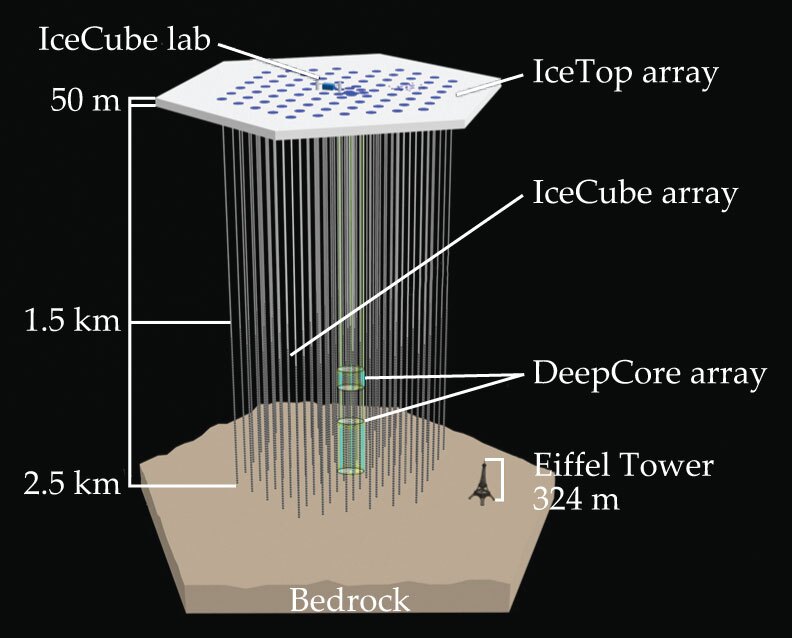
Figure 1. IceCube, a cubic kilometer of ice deep under the South Pole, uses 5000 photodetectors deployed along 86 strings to track muons created in the ice by high-energy neutrinos. Its new DeepCore sub-array facilitates IceCube’s search for evidence of dark-matter particles accumulating and annihilating in the Sun.
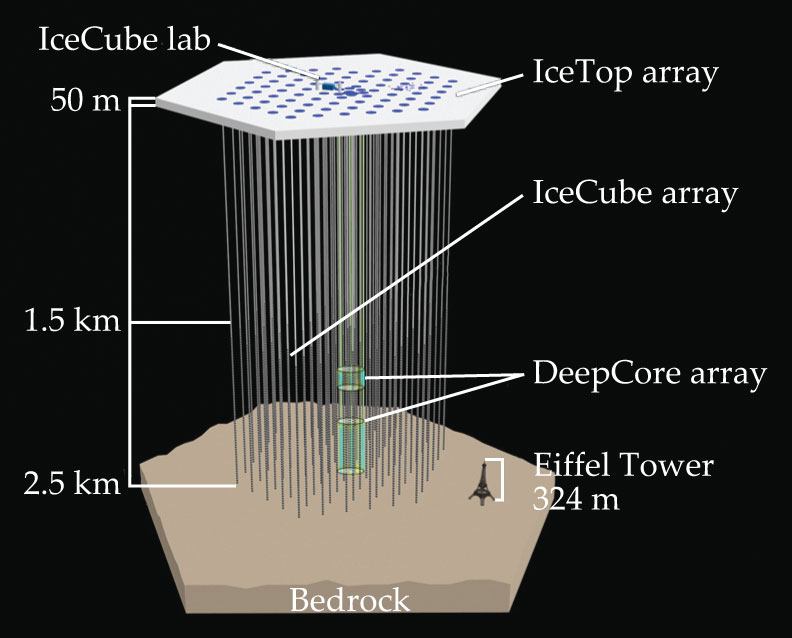
To that end, below 1.5 km, most strings have a photodetector module every 17 m to record light that a muon passing nearby generates through ionization and other energy-loss mechanisms. (See the article by Halzen and Spencer Klein in Physics Today, May 2008, page 29
Because χ0 is, by hypothesis, its own antiparticle and the lightest of all supersymmetric particles, two of them will annihilate into ordinary particles when they collide. But they’re too sparse in most of the galactic halo to produce a discernible annihilation-neutrino flux. In the deep gravitational well at the center of the Sun, however, they’re thought to have been accumulating and annihilating for billions of years. Neutralinos traversing the Sun at anything like 300 km/s can’t be gravitationally trapped. But a minuscule fraction of them should be sufficiently slowed for trapping by collisions with protons in the Sun.
The trapping rate depends crucially on the χ0p elastic-scattering cross section σχp, which varies from model to model. In most MSSMs, it’s big enough for the Sun to have reached, by now, a steady-state equilibrium between χ0 trapping and annihilation.
If the χ0 is heavier than the 80-GeV W± bosons that mediate the weak nuclear interactions, an important annihilation mode might be
χ0 + χ0 → W+ + W−.
Subsequent W± decays would yield a high-energy (“hard”) spectrum of neutrinos with typical energies around mχ/2.
Any particular MSSM specifies mχ, σχp, and the probabilities of different annihilation modes. Thus it explicitly predicts the flux of neutrinos from the solar core. “If the predicted flux exceeds IceCube’s detection threshold and we don’t see it, we’ve excluded that model,” says Halzen. “Detailed assumptions about solar astrophysics don’t come into it. All we really need to know is how many protons there are in the Sun.”
Low-mass thresholds
A muon created in the ice by a high-energy neutrino has almost the same energy and direction as its progenitor. TeV muons recorded in IceCube typically originate several kilometers outside the array. In its original configuration, IceCube had a muon-energy threshold of about 50 GeV. A 250-GeV muon loses all its kinetic energy in only 250 meters. Muons of still lower energies have proportionately shorter ranges in ice, which means they’re unlikely to be seen by more than one photodetector module. So, in effect, IceCube couldn’t search for the annihilation of WIMPs lighter than about 100 GeV. But predictions extend to much lower WIMP masses.
Therefore IceCube’s WIMP search has been exploiting DeepCore, an upgrade completed just before the newly reported year-long search began. DeepCore, indicated in figure 1, is a central sub-array more densely and sensitively instrumented than the rest of IceCube. In its vicinity, the muon-energy threshold is down to 10 GeV, which lets the search team consider WIMP masses as low as 20 GeV.
The data analysis separated some 10 000 candidate muon tracks found over the year into three categories for different seasons and acceptance volumes, and therefore different energy distributions, instrumental uncertainties, and cosmic-ray backgrounds. For each category, figure 2 shows the angular distribution of inferred neutrino directions that point back to within 10° of the Sun’s position at the recorded time.
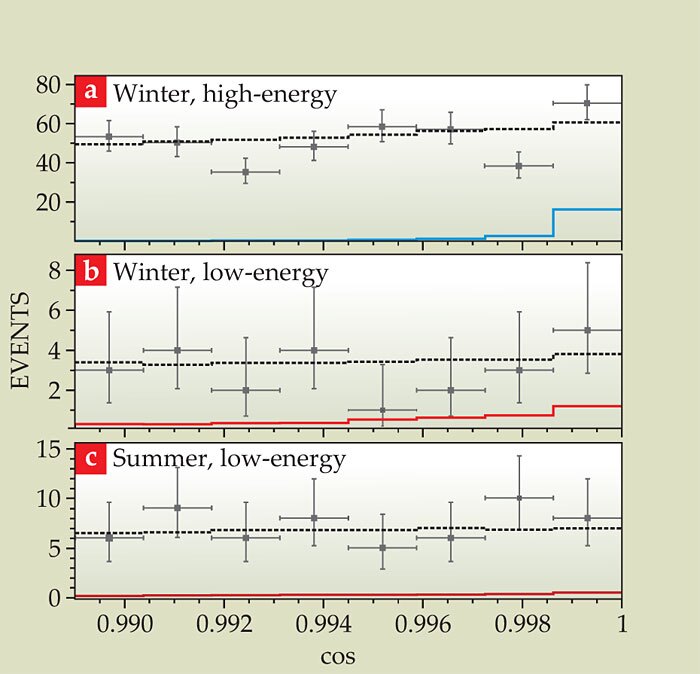
Figure 2. IceCube’s recorded distributions of the angle θ between the Sun and the inferred directions of candidate neutrinos from WIMP annihilations in the solar core. Three different seasonal and energy-distribution categories, explained in the text, are plotted together with their expected backgrounds (dashed lines). All three observed distributions are consistent with backgrounds only. Colored histograms show the strongest annihilation signal consistent with the null result for a WIMP mass of (a) 1000 GeV or (b, c) 50 GeV. (Adapted from ref.
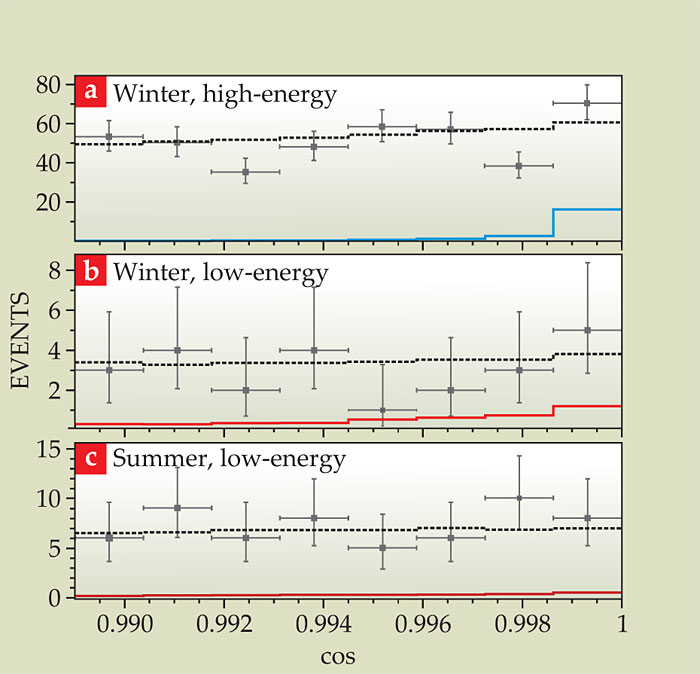
The largest category (figure 2a), with the highest typical energies and therefore the best pointing precision, requires only that the event was recorded in the six winter months when the polar Sun never rises, and that the muon did not originate in DeepCore. Because the other two categories require that the muon did originate in DeepCore, they overrepresent low-energy muons. Figure 2b plots winter DeepCore events. Events originating in DeepCore during the six summer months when the Sun never sets are plotted in figure 2c.
Season matters because monitoring the Sun without the shielding aid of Earth’s bulk has to contend with an unrelenting rain of impostor muons and neutrinos from cosmic-ray showers in the atmosphere. Before DeepCore, it couldn’t be done.
Limits
All three observed distributions are consistent with no signal events at all—nothing but background. The null result yields a 90%-confidence upper limit on the number of signal events and their directional distribution for any particular WIMP mass and annihilation mode. For example, figure 2a shows that upper-limit signal if mχ is 1000 GeV and the annihilation mode is W+W−. IceCube’s directional resolution for such events is about 0.5°.
From the limits on signal size, the team determined 90%-confidence upper limits on σχp as a function of WIMP mass. The smaller the signal, the smaller must be the scattering cross section that slows WIMPs down to trappable speeds.
Those cross-section limits are plotted in figure 3, along with recent limits from three nuclear-recoil searches. Also shown are earlier limits from Super-Kamiokande, 2 the 50-kiloton Japanese neutrino detector that pioneered the search for WIMP annihilation in the Sun.
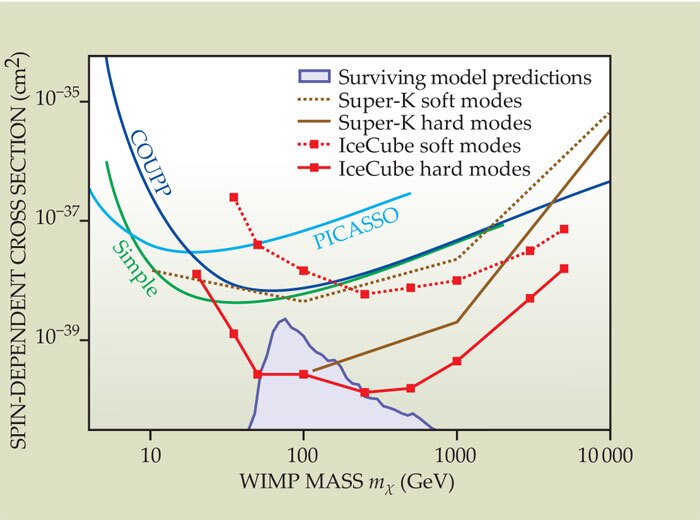
Figure 3. Upper limits, at 90% confidence, on the spin-dependent cross section for elastic scattering of WIMPs off protons, deduced from annihilation searches by IceCube and Super-Kamiokande, and from recent searches at three nuclear-recoil detectors. For the annihilation detectors, pairs of limit curves are shown, corresponding to “hard” and “soft” annihilation modes that are, respectively, the most and least detectable. IceCube’s hard-mode limit cuts away a significant portion of the (shaded) parameter space of minimal supersymmetric models that had survived earlier searches at accelerators and recoil detectors. (Adapted from ref.
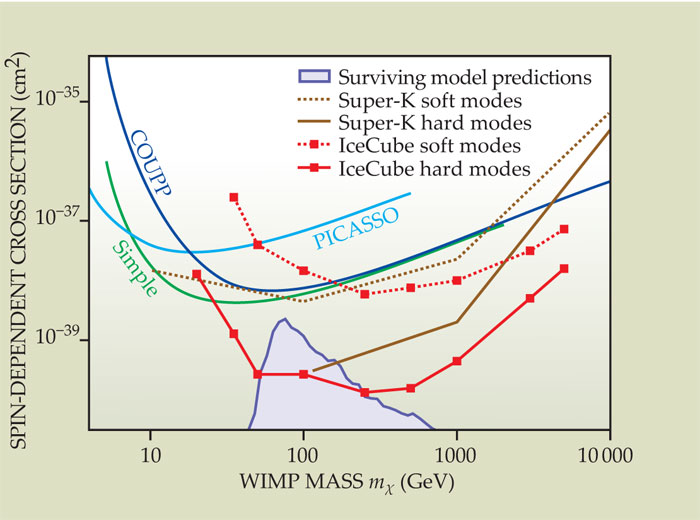
Because annihilation limits depend on what annihilation modes are assumed, pairs of limit curves are shown for IceCube and Super-Kamiokande, corresponding to two extreme choices that effectively bracket the range of annihilation modes predicted by MSSMs. The lower curves consider only annihilations to W+W− or, for lower WIMP masses, to pairs of tau leptons. Those “hard” modes yield the most energetic, therefore most easily detected neutrinos. The “soft” (least visible) modes are annihilations to meson pairs.
For WIMP masses above 35 GeV, IceCube’s hard-mode curve is the most stringent upper limit yet. After only one year of observing with DeepCore in place, it already cuts well into the parameter space of MSSMs that had survived earlier null results from recoil and accelerator searches. Collisions in accelerators should create WIMPs, but beam energies impose restrictive mass limits. Even with CERN’s Large Hadron Collider, one can’t search for WIMPs much heavier than 500 GeV.
The two-dimensional representation of MSSM parameter space in figure 3 is just a projection. More parameters are needed to describe the mixture of annihilation modes predicted by any particular model. So the most stringent IceCube limit in the figure applies only to the many models in which hard modes predominate.
The modifier “spin-dependent” in the ordinate label of figure 3 needs explaining. The χ0p elastic-scattering cross section has two distinct contributions. The dominant term, plotted in the figure, depends on the spin state of the χ0p system; the other doesn’t. Though the spin-independent contribution is small in the mostly hydrogen Sun, its coherent amplification in scattering off a heavy nucleus makes it important in most recoil searches.
Another kind of WIMP search is gaining attention. WIMP annihilation would also produce positrons. Unlike neutrinos, positrons have short, crooked trajectories; but they’re easier to detect. The rising positron fraction with increasing energy above 10 GeV in the cosmic-ray spectrum is suggestive of WIMP annihilation. An eventual abrupt falloff of that rise would reflect the WIMP’s mass. Such a falloff hasn’t yet been seen. But a spectacularly precise positron spectrum leveling off near 350 GeV, just published by the Alpha Magnetic Spectrometer collaboration, 3 has WIMP watchers waiting for the other shoe to drop.
References
1. M. G. Aartsen et al., Phys. Rev. Lett. 110, 131302 (2013). https://doi.org/10.1103/PhysRevLett.110.131302
2. T. Tanaka et al., Astrophys. J. 742, 78 (2011). https://doi.org/10.1088/0004-637X/742/2/78
3. M. Aguilar et al. (AMS collaboration), Phys. Rev. Lett. 110, 141102 (2013).https://doi.org/10.1103/PhysRevLett.110.141102
